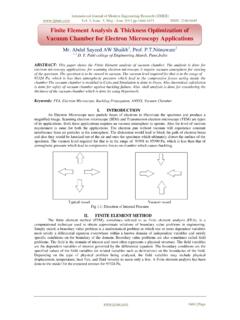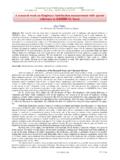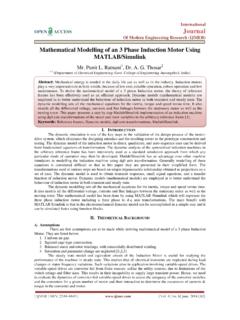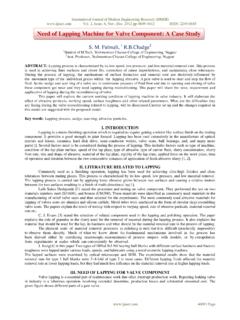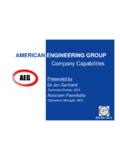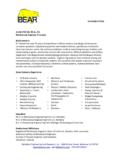Transcription of Design and Analysis Special Shaped Milling Cutter …
1 International Journal of Modern Engineering Research (IJMER) Vol. 3, Issue. 6, Nov - Dec. 2013 pp-3716-3722 ISSN: 2249-6645 3716 | Page K. Chaitanya1, M. Kaladhar2 student,Department of Mechanical Engineering, Raghu Engineering College,Visakhapatnam,Andhra Pradesh, India 2 Associate Professor, Department of Mechanical Engineering, Raghu Engineering College,Visakhapatnam,Andhra Pradesh, India ABSTRACT: Milling is a production process which is based on material removal using multipoint cutting tools, as a result higher material removal rates can be achieved along with high surface finish.
2 The common operations performed on Milling machine are: facing, shaping, slot cutting, drilling, T-slot cutting etc. This paper presents an indiscriminate model of Special Shaped Milling Cutter made of high speed steel material for the purpose of predicting stress and deformation on it. At sudden torque applied by machine, harmonic motion, natural frequency and also loads acting on the Cutter at varying speed and Cutter thickness. The results obtained with the aid of FEM software for stresses are compared with theoretical values of stresses. Keyword: catia, Milling , FEM, Ansys I.
3 Introduction Increasing the productivity and the eminence of the machined parts are the main challenges of metal-based industry. There has been increased interest in monitoring all aspects of the machining process. These machines assisted man in maintaining accuracy and uniformity while duplicating parts that could not be manufactured with the use of a file. Development and improvements of the Milling machine and components continued, which resulted in the manufacturing of heavier arbors and high speed steel and carbide cutters. These components allowed the operator to remove metal faster, and with more accuracy, than previous machines.
4 Variations of Milling machines were also developed to perform Special Milling operations, Milling is the process of machining flat, curved, or Milling machines are basically classified as vertical or irregular surfaces by feeding the work piece against a rotating horizontal. These machines are also classified as knee-type, Cutter containing a number of cutting edges. The Milling ram-type, manufacturing or bed type, and planer-type, Most machine consists basically of a motor driven spindle, which Milling machines have self-contained electric drive motors, mounts and revolves the Milling Cutter , and a reciprocating coolant systems, variable spindle speeds, and power-operated adjustable worktable, which mounts and feeds the work piece, table feeds [1,2].
5 This paper aims to develop an optimum geometric model of a plain Cutter based on the application. To overcome the difficulties associated with modeling a complex Cutter , an interface in the form of a customized tool Design modeler is developed. This Design tool can render the three-dimensional geometry of the Cutter in any commercial CAD environment for validation and Design improvements. In this work, the proposed 3D model of the Special Shaped Milling Cutter is used for finite element Analysis to optimize its Design . The results of stress distribution and deformation are presented.
6 II. Literature Review Mohammed and Tandon (2000) developed geometric Design model of a brazed insert-based CEFM Cutter in terms of three-dimensional (3D) parameters. The model defined the CEFM Cutter in terms of 3D rotational angles and also developed a provision of interface of 3D CEFM Cutter directly for the purpose of methodology validation. Finite element Analysis (FEA) was used to determine the effects on cutting insert under transient dynamic load conditions. [3] Mohammed and Tandon (2000) proposed a shape Design methodology in order to develop the geometry of a generic Special Shaped Milling Cutter .
7 The proposed three-dimensional parametric definition of the Cutter with varying the rake angle of the insert and insert seat was analyzed using FEM. Though there is a good amount of work is done by the researcher to study and develop the various models for the conventional single point and multipoint cutting tools, but a few works have been recorded on the development of Special Shaped Milling Cutter model. [4] III. Kinds of Milling Cutters Plain Milling Cutter : The most common type of Milling Cutter is known as a plain Milling Cutter . It is merely a metal cylinder having teeth cut on its periphery for producing a flat horizontal surface.
8 Metal Slitting Saw Milling Cutter : The metal slitting saw Milling Cutter is essentially a very thin, it is ground slightly thinner toward the center to provide side clearance. It is used for metal sawing and for cutting narrow slots in metal. End Milling Cutters: End Milling cutters, also called end mills, have teeth on the end as well as the periphery. The smaller end Milling cutters have shanks for chuck mounting or direct spindle mounting. Larger end Milling cutters are called shell end Milling cutters and are mounted on arbors like plain Milling cutters. End Milling cutters are employed in the Design and Analysis Special Shaped Milling Cutter Using Finite Element Analysis International Journal of Modern Engineering Research (IJMER) Vol.
9 3, Issue. 6, Nov - Dec. 2013 pp-3716-3722 ISSN: 2249-6645 3717 | Page production of slots, keyways, recesses, and tangs. They are also used for Milling angles, shoulders, and the edges of work pieces. Concave and Convex Milling Cutters: Concave and convex Milling cutters are formed tooth cutters Shaped to produce concave and convex contours of one-half circle or less. The size of the Cutter is specified by the diameter of the circular form the Cutter produces. Corner-rounding Milling Cutter : The corner-rounding Milling Cutter is a formed tooth Cutter used for Milling rounded corners on work pieces up to and including one-quarter of a circle.
10 The size of a Cutter is specified by the radius of the circular form the Cutter produces, as with concave and convex cutters. Special Shaped -formed Filing Cutter : Formed Milling cutters have the advantage of being adaptable to any specific shape for Special operations. The Cutter is made for each specific job. In the field, a fly Cutter is made to machine a specific shape. T-Slot Milling Cutter : The T-slot Milling Cutter is used to machine T-slot grooves in worktables, fixtures, and other holding devices. The Cutter has a plain or side Milling Cutter mounted to the end of a narrow shank.
